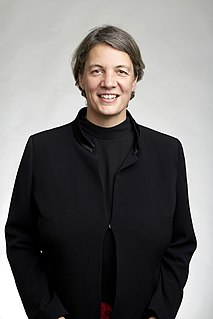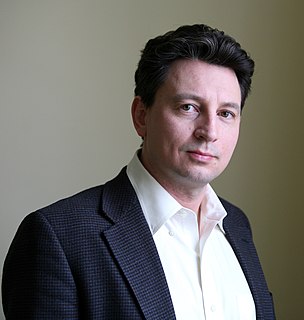Rahul Sarpeshkar is the Thomas E. Kurtz Professor and a Professor of Engineering, Professor of Physics, Professor of Microbiology & Immunology, and Professor of Molecular and Systems Biology at Dartmouth. Sarpeshkar, whose interdisciplinary work is in bioengineering, electrical engineering, quantum physics, and biophysics, is the inaugural chair of the William H. Neukom cluster of computational science, which focuses on analog, quantum, and biological computation. The clusters, designed by faculty from across the institution to address major global challenges, are part of President Philip Hanlon’s vision for strengthening academic excellence at Dartmouth. Prior to Dartmouth, Sarpeshkar was a tenured professor at the Massachusetts Institute of Technology and led the Analog Circuits and Biological Systems Group. He is now also a Visiting Scientist at MIT's Research Laboratory of Electronics.
Sir Michael Pepper, FRS, FREng is a British physicist notable for his work in semiconductor nanostructures.

The Faculty of Science is a constituent body of the University of New South Wales (UNSW), Australia. It is UNSW's second largest Faculty. It has over 400 academic staff and over 700 research staff and students.
David Keane Ferry is the Regents' Professor of Electrical Engineering at Arizona State University (ASU), notable for his research in semiconductor devices.

Alexander A. Balandin is an electrical engineer, solid-state physicist and materials scientist best known for an experimental discovery of unique thermal properties of graphene and their theoretical explanation; studies of phonons in nanostructures and low-dimensional materials, which led to the development of the field of phonon engineering; investigation of low-frequency electronic noise in materials and devices; and demonstration of the first charge-density-wave devices operating at room temperature.
Roderick Melnik is a Canadian-Australian mathematician and scientist, internationally known for his research in applied mathematics, numerical analysis, and mathematical modeling for scientific and engineering applications.

Michelle Yvonne Simmons, is a Scientia Professor of Quantum Physics in the Faculty of Science at the University of New South Wales and has twice been an Australian Research Council Federation Fellow and is an Australian Research Council Laureate Fellow. She is the Director of the Australian Research Council Centre of Excellence for Quantum Computation & Communication Technology and is recognised internationally as a pioneer in atomic electronics. She is also editor-in-chief of npj Quantum Information, an academic journal publishing articles in the emerging field of quantum information science. On 25 January 2018, Simmons was named as the 2018 Australian of the Year for her work and dedication to quantum information science. On 10 June 2019, Simmons was appointed an Officer of the Order of Australia (AO) in the 2019 Queen's Birthday Honours in recognition of her "distinguished service to science education as a leader in quantum and atomic electronics and as a role model."

Gerard James Milburn is an Australian theoretical quantum physicist notable for his work on quantum feedback control, quantum measurements, quantum information, open quantum systems, and Linear optical quantum computing.
Xue Qikun is a Chinese physicist. He is a professor of Tsinghua University, Beijing. He has done much work in Condensed Matter Physics, especially on superconductors and topological insulators. In 2013, Xue was the first to achieve the quantum anomalous Hall effect (QAHE), an unusual orderly motion of electrons in a conductor, in his laboratory at Tsinghua University. Xue is a member of the Chinese Academy of Sciences, vice president for research of Tsinghua University, and director of State Key Lab of Quantum Physics. In 2016 he was one of the first recipients of the new Chinese Future Science Award for experimental discovery of high-temperature superconductivity at material interfaces and the QAHE. This award has been described as "China's Nobel Prize".
Biswa Ranjan Nag was an Indian physicist and the Sisir Kumar Mitra chair professor at Rajabazar Science College, University of Calcutta. Known for his research in semiconductor physics, Nag was an elected fellow of Indian National Science Academy and Indian Academy of Sciences. The Council of Scientific and Industrial Research, the apex agency of the Government of India for scientific research, awarded him the Shanti Swarup Bhatnagar Prize for Science and Technology, one of the highest Indian science awards for his contributions to Physical Sciences in 1974.

The ARC Centre of Excellence in Future Low-Energy Electronics Technologies is a collaboration of physicists, electrical engineers, chemists and material scientists from seven Australian universities developing ultra-low energy electronics aimed at reducing energy use in information technology (IT). The Centre was funded in the 2017 ARC funding round.
Kourosh Kalantar-zadeh is an Australian scientist involved in research in the fields of materials sciences, electronics, and transducers. He is best known for his works on two-dimensional semiconductors, ingestible sensors and liquid metals. He led his group to the invention of an ingestible chemical sensor: human gas sensing capsule..
Karl Hess is the Swanlund Professor Emeritus in the Department of Electrical and Computer Engineering at the University of Illinois at Urbana–Champaign (UIUC). He helped to establish the Beckman Institute for Advanced Science and Technology at UIUC.
Michael Fuhrer is a US/Australian physicist recognised internationally as a pioneer in atomically-thin (two-dimensional) materials, including graphene and novel topological materials, with expertise in fabrication and characterisation of their electronic and optical properties.
Xiaolin Wang is a Chinese/Australian scientist recognised for his work in advanced materials synthesis and characterisation and spintronics. He is director of the Institute for Superconducting and Electronic Materials, University of Wollongong. Wang is a University of Wollongong senior professor, and an Australian Research Council future fellow.

Matthew Davis is a New Zealand/Australian physicist, and is Head of Physics at the University of Queensland, Australia. He is known for his work on the dynamics of vortices and superfluidity in Bose–Einstein condensates, particularly at finite temperatures
Professor Lan Wang is a Chinese/Australian material scientist known for expertise in materials synthesis and advanced materials characterisation.

Jared Cole is an Australian theoretical physicist specialising in quantum physics and decoherence theory and its application to solid-state systems. He specialises in using mathematical and computational models to describe the design and operation of quantum computing and quantum electronic devices.

Victor Galitski is a Russian-American physicist, a theorist in the areas of condensed matter physics and quantum physics.
Francesca Iacopi is an engineer, researcher and an academic. She specializes in materials and nanoelectronics engineering and is a Professor at the University of Technology Sydney. She is a chief investigator of the ARC Centre of Excellence in Transformative Meta-Optical Systems, a Fellow of the Institution of Engineers Australia, and a senior member of Institute of Electrical and Electronics Engineers.







